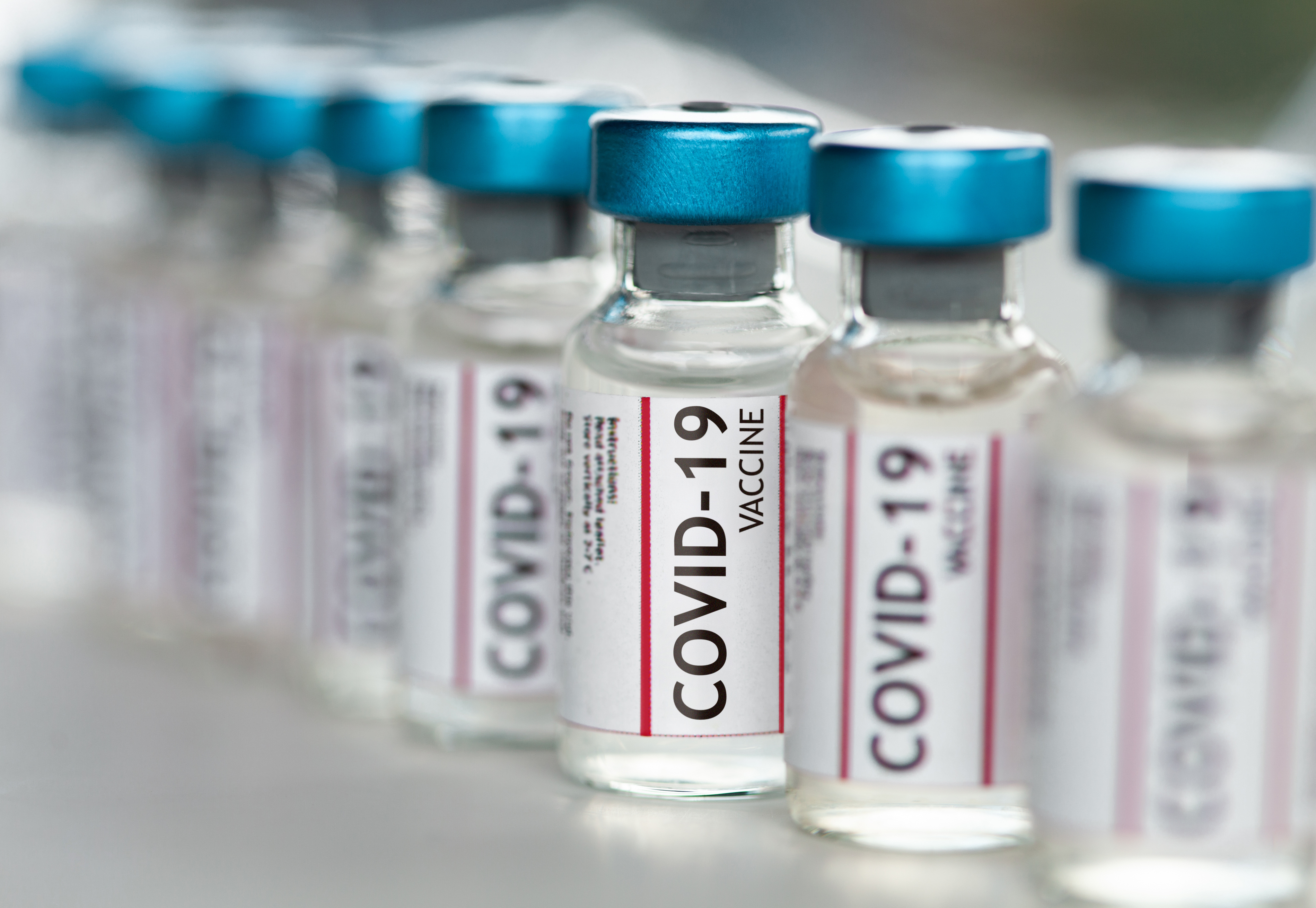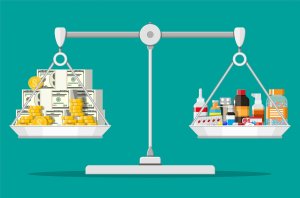Mass production of COVID-19 vaccines
With the identification of the genetic sequence of SARS-CoV-2 in January 2020, a number of research teams around the world embarked on the development of COVID-19 vaccines. Before the year was out, two vaccines had been granted emergency authorization by the U.S. Food and Drug Administration (FDA), and approval of a third is expected this month. Still, an unprecedented challenge is underway: the mass production of authorized COVID-19 vaccines as quickly as possible while maintaining quality standards.
At two shots per inoculation, the 5.5 billion people worldwide age 18 or over would need 11 billion doses. It has been estimated that 75 percent of the world’s population must be vaccinated to end the pandemic, which means that the delivery of 8.3 billion doses of COVID-19 vaccine would be required even to begin a return to normal—that is, assuming that these versions of the vaccines are effective against SARS-CoV-2 mutations. The authorization of the one-dose Johnson & Johnson vaccine could bring down the total number of doses required by as much as one billion over the coming year. At the same time, the longer it takes to produce the billions of doses needed to make herd immunity possible, the greater the probability that mutations of the coronavirus will occur that will render existing vaccines less effective.
As doses of authorized vaccines are becoming available, the logistical challenges of quickly putting shots into billions of arms at an unprecedented pace have become evident. Even as these “last mile” problems of vaccine delivery are solved, however, the more fundamental constraint on mass inoculation will be getting access to the limited supply of vaccine that can be produced in any given period of time. At play are three distinct constraining factors, which we label “capacity,” “scale,” and “control.”
· Capacity: the manufacturing capacity that is now available for this effort globally and viable plans to add to it within a short timeframe;
· Scale: the scaling of this capacity to the highest possible level of throughput (output per unit of time) by solving logistical supply problems while maintaining the requisite standard of quality for the doses produced; and
· Control: the exercise of power by business firms, government agencies, and civil-society organizations to control the allocation of the vaccine supply.[1]
Investment in vaccine-manufacturing capability entails high degrees of technological, market, and competitive uncertainty. In advance of a pandemic, it cannot be known what type of vaccine will be necessary, what specific type of manufacturing capacity will be required to produce it, or when and at what scale it will be needed. Even when the pandemic is upon us, and it becomes widely known how contagious and debilitating it can be, there remains uncertainty as to what types of vaccines under development may gain regulatory approval, when the vaccine authorizations will occur, and, in the meantime, how effective other pandemic countermeasures—therapies, social distancing, mask protection, testing, tracing, and quarantining—may be in tamping down the general urgency surrounding rapid production and distribution of safe and effective vaccines.
Moreover, given that almost all final decisions to invest in vaccine manufacture are made by oligopolistic business firms, it is uncertain whether their combined investments in vaccine-manufacturing capacity, including relevant supply chains, will be adequate to mounting a rapid response that might vanquish the pandemic through inoculations on a global scale. Under these conditions, national governments, transnational blocs, and civil-society coalitions will compete for access to limited manufacturing capacity, as is indeed currently the case.
Once a COVID-19 vaccine has gained regulatory approval, therefore, understanding the evolving issues of capacity, scale, and control of vaccine manufacturing is critical to crafting public policy that can provide for the delivery of safe and effective vaccines to billions of people as quickly as possible. It is from this perspective that the contributors to the INET-AIR COVID Vaccine Project are studying and reporting on the rollout of COVID-19 vaccines. Based on intensive research that employs a multitude of data and news sources, the INET-AIR COVID Vaccine Project will provide regular analyses of capacity, scale, and control in the mass production of COVID-19 vaccines.
The speed at which the population is vaccinated is important for bringing COVID-19 under control, while the allocation of vaccine among various demographic groups is crucial for achieving a just and efficacious response to the COVID crisis within nations. It is our view, however, that progress in the implementation of the vaccination process will reveal severe shortfalls in the capabilities of vaccine producers to supply doses and, as a result, an exacerbation of “vaccine nationalism.” The INET-AIR COVID Vaccine Project is focusing on the supply of doses and its allocation among nations.
An understanding of the problems and possibilities of the enormous COVID-19 mass-production effort can provide timely insights into the state of the battle against the coronavirus and the potential that remains for deploying vaccines to defeat it. Armed with this information, we can also consider how the particular business firms that control the mass-production capability and government agencies that establish relations with these business firms may be influencing which demographic segments in which countries gain access to the vaccines, as well as when and at what cost the vaccines become available to them.
COVID-19 vaccine manufacturing capacity
Historically, major pharmaceutical companies have tended to avoid the development and manufacture of vaccines. Therapies that are not curative are, by definition, more profitable. Given the scale and speed of mass-vaccination campaigns, drug manufacturers may be especially reluctant to confront the significant liability issues that can be connected with adverse reactions to a vaccine by even a very small proportion of the inoculated population. Moreover, vaccines are produced on a large scale under government procurement contracts, with negotiated prices that reduce profit margins.
As a result, coming into the COVID-19 pandemic, most of the major drug companies of Europe and the United States—known collectively as Big Pharma—had abandoned in-house vaccine manufacturing. At the beginning of 2020, various mergers and acquisitions had left just four Big Pharma companies—GlaxoSmithKline (UK), Merck (USA), Pfizer (USA), and Sanofi Pasteur (France)—with about 85 percent of the world’s $35-billion vaccine market. In recent years, US-based Johnson & Johnson (J&J) has been investing in vaccine development and manufacturing through its wholly owned subsidiary, Janssen (Belgium). The INET-AIR COVID Vaccine Project is documenting the extent to which Big Pharma’s capacity is being devoted to the production of COVID-19 vaccines.
In addition to vaccine-manufacturing capacity directly under the control of Big Pharma, a number of pharmaceutical contract development and manufacturing organizations (CDMOs) have production facilities that are now being mobilized to produce COVID-19 vaccines. These companies’ growth in the 1980s and 1990s was a complement to the rise of New Economy biopharma companies that develop medicines but forgo investing in their own manufacturing facilities. Big Pharma companies have also become increasingly reliant on CDMOs, which own and operate facilities throughout the world. Over the past two decades, as the CDMO sector has grown, it has become more concentrated through mergers and acquisitions. China, India, and Russia also possess substantial vaccine manufacturing capacity that can possibly be made available for COVID-19 vaccines. For example, the Serum Institute of India is the world’s largest vaccine producer and has contracts to manufacture the Novovax and AstraZeneca/Oxford COVID-19 candidates for use in India.
With the world’s vaccine manufacturers providing vague estimates concerning the amount of capacity prospectively available for the production of COVID-19 vaccines, we will only become aware of how much capacity can actually be mobilized to fight the pandemic as the rollout of authorized vaccines occurs. The INET-AIR COVID Vaccine Project is monitoring and documenting this process. We view the following table derived from the Financial Times COVID-19 vaccine tracker as just a starting point for this investigation.
Company | Production capacity (doses) | Facility locations |
BioNTech/Pfizer | Up to 2.0 billion, 2021 | USA, Belgium, Germany |
Moderna | 600 million to 1 billion, 2021 | USA, Switzerland, Spain |
AstraZeneca/Oxford University | 3 billion, 2021 | UK, India, Brazil |
Johnson & Johnson (single dose) | 1 billion, 2021 | USA, Europe, Asia, Africa |
Novavax | 1 billion to 2 billion doses, 2021 | USA, Europe, South Korea |
Medicago/GS | 80 million, 2021, to 1 billion, 2023 | USA, Canada |
CureVac | 300 million, 2021; 600 million, 2022 | Europe(?) |
Gamaleya Institute | “It is seeking to expand capacity.” | Russia |
CanSino (single dose) | 300 million, 2021 | China |
Sinopharm I and Sinopharm II | More than 1 billion, 2021 | China |
SinoVac | 600 million, 2021 | China |
ZFSW | 300 million, 2021 | China |
Bharat Biotech | 300 million, 2021; to 500 million/yr. | India |
Assuming that the production capacity for the Russian vaccine, Sputnik B developed by Gamaleya Institute, is between 300 million and 600 million doses in 2021, the estimated capacity for 2021 derived by adding up the figures for the 14 vaccines in the table is between 10.5 billion and 12.2 billion doses. There are, however, many reasons why such an optimistic outlook would be a vast overestimate.
· The numbers in this table are broad estimates, with virtually no documentation from the vaccine producers. Absent such evidence, it is unclear whether or not these estimates include production capacity for non-COVID vaccines.
· Different types of vaccine entail different production technologies, so the usability of capacity depends on which vaccines gain authorization.
· There may be double counting of capacity because different vaccine developers may be assuming that they will have access to the capacity of the same manufacturing facilities if and when their respective vaccines are authorized.
· There are myriad issues of scaling the capacity that is currently available to achieve these estimates of total annual output, as we discuss separately.
Indeed, as we will document in subsequent articles of the INET-AIR COVID Vaccine Project, closer scrutiny of these data suggests that, even if many more COVID-19 vaccines obtain regulatory authorization in 2021, over the course of this year the global capacity available might at best supply no more than two billion doses—about a quarter of the number required to contain the pandemic. The Duke Global Health Innovation Center refers to a recent model predicting that vaccine supply will not be able to meet global demand until 2023 or 2024. Adar Poonawalla, CEO of Serum Institute of India has put forth an even more pessimistic timeframe.
Moreover, we know very little right now about the length of time for which vaccines will provide immunity, and hence even two shots of a vaccine may not achieve the efficacy we need. And there is the problem of mutations: On February 7, it was announced that South Africa had halted the use of the AstraZeneca/Oxford vaccine because it had been found to be relatively ineffective in fighting the new variant of the virus which had spread throughout that nation.
Scaling mass-production of COVID-19 vaccines
Over time, capacity will not, of course, be limited to that of currently existing plant. The supply of manufacturing capacity can be expanded through the transformation of existing facilities and the building of new ones. There is some information becoming available on the expansion plans of vaccine manufacturers, but questions remain about the timeframes required to make new capacity functional, as well as about the availability of vaccine-manufacturing equipment for installation in converted or newly constructed plant, on which those timeframes may depend. There are also critical questions about the learning process, which determines actual capacity, involved in transferring the vaccine technology from developers to CDMOs as well as improvements in efficiency of a given manufacturing facility through learning-by-doing.
Even for existing capacity, there are all kinds of logistical issues related to supply chains and quality control that must be addressed in order to scale to maximum throughput. Indeed, there are numerous stages of manufacturing, each of which takes place at a specialized plant. For example, the manufacture of the BioNTech/Pfizer vaccine for the U.S. market begins with the processing of raw materials at a facility in Montana, the further transformation of the materials into the vaccine at a Massachusetts manufacturing plant, and then the final processing and packaging (or “fill-and-finish”) of the vaccine in Michigan. Depending on the vaccine technology, there can be shortages of chemical ingredients and other raw materials, especially when vaccine companies are competing for the same inputs. There is always a danger of contamination at the various manufacturing stages, which can result in delays in production or even the loss of millions of doses. On the positive side, we can expect that over time learning-by-doing will enable suppliers to improve the efficiency of the inputs that they provide. But bottlenecks will inevitably occur as the vaccine manufacturers ramp up throughput.
Supply-chain and equipment issues can arise along the finished vaccine’s complex route to its purchasers. For example, a shortage of medical glass for packaging has led Pfizer to put more doses into each vial than it would ordinarily. But this workaround then ran up against a shortage of the low dead-volume syringes needed to extract the last dose in each vial. When the first batches of authorized BioNTech/Pfizer vaccines were ready for shipment, the buyer, the U.S. government’s Operation Warp Speed (OWS), was unable to take possession of a large part of the order: It had apparently failed to secure sufficient sensors for continuous monitoring of the ultra-freezing temperature of the mRNA vaccine. And even with meticulous management, a certain amount of wastage, ranging from one to ten percent of a total batch, is generally expected in the production of vaccines.
The INET-AIR COVID Vaccine Project will monitor and report on these scaling questions as information becomes available during the COVID-19 vaccine rollout.
Control of mass-production capacity and distribution of COVID-19 vaccines
Who controls access to the COVID-19 vaccines that are manufactured? On the supply side, it is the companies that possess the manufacturing facilities. The German company BioNTech had to turn to Pfizer for manufacturing and delivery of the mRNA vaccine it had developed, with the result that it is now generally called the “Pfizer” vaccine in the United States.
Pfizer has demonstrated the power of the possession of manufacturing and distribution capability, not only by obtaining the agreement from BioNTech, but also by opting to convert the plant it dedicated to COVID-19 vaccine production without taking subsidies for clinical trials or manufacturing extension from the U.S. government’s OWS. This contrasts with the nearly $1 billion that Moderna received from OWS for developing and manufacturing its vaccine. In July 2020, Pfizer had already received an OWS advance purchase agreement for $1.95 billion for 100 million doses, even before the completion of clinical trials. By not accepting government subsidies for clinical trials or manufacturing extension, however, Pfizer retained freedom to determine the terms under which it would deliver additional doses. As a result, after its vaccine had received emergency authorization, Pfizer was able to bargain to supply OWS with another 100 million doses in return for assurances from OWS that Pfizer would have privileged access to the materials needed for manufacturing them.
On the demand side, government agencies and civil-society organizations around the world have been active since March 2020 in entering into procurement contracts with prospective manufacturers of candidate COVID-19 vaccines. In many cases, based on these contracts, production of vaccines has been started before the vaccines have gained regulatory approval.
A small number of key coalitions of nations, civil-society organizations, or both have emerged to wield more procurement clout. The European Union has been doing procurement as a bloc, although it has been criticized by Germany, as a member nation, for its failure to secure an adequate prospective supply. COVAX is an international consortium aligned with the World Health Organization (WHO) that was formed to support the development of COVID-19 vaccines, the building of manufacturing capabilities, and the procurement of two billion doses to be distributed equitably among the neediest of the world’s population by the end of 2021.
The United States, whose six-month withdrawal from WHO was reversed in January by President Biden, is now a member of COVAX. Nevertheless, in seeking to ramp up the rate of COVID-19 vaccinations in the United States, in the wake of the incompetence (and possible corruption) of the Trump administration, the Biden administration appears to have been putting America first in controlling the COVID-19 vaccine supply. The INET-AIR COVID Vaccine Project will monitor the shifts now expected in U.S. policy focus and implementation toward supporting a more collaborative agenda for making the vaccines available globally on an equitable basis. At the same time, we will analyze the relation between the progress in solving the problems of vaccine supply and the larger Biden administration agenda for overcoming the pandemic. Ultimately, we hope that this project will contribute to the much-needed debate on how government and business can collaborate to prepare for and respond to pathogen pandemics now and in the future.
[1] See Lynn Parramore, “4 Burning Questions on the Global Vaccine Rollout,” Institute for New Economic Thinking, December 29, 2020, based on interviews with William Lazonick and Öner Tulum.





